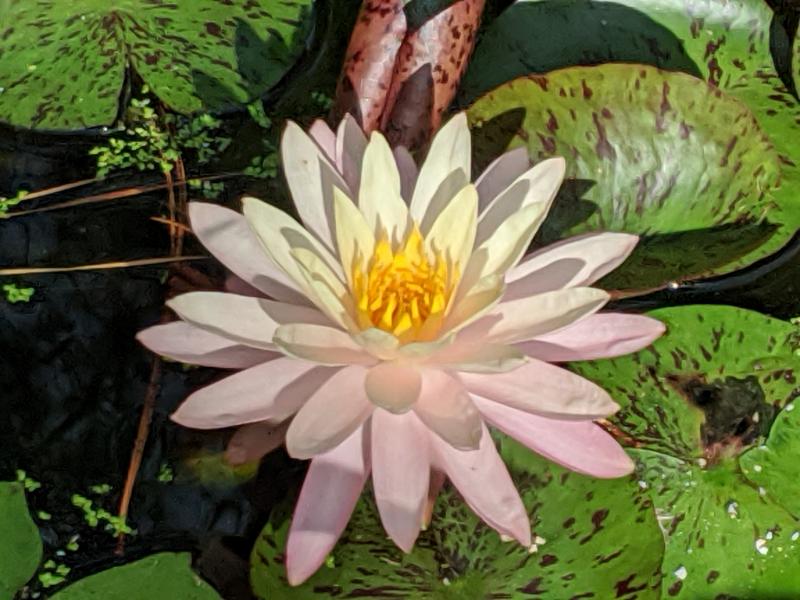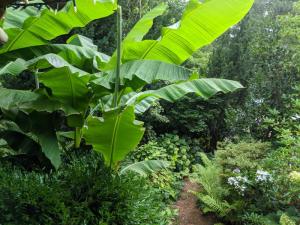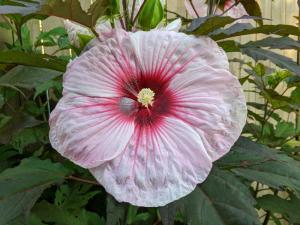Midsummer gardens are now changing gears from flowers leading the display to foliage plants showing their muscles. It is also the peak for the largest flowers of the garden year on the hibiscus, which offers choices of several species and many stunning cultivars.
Mill Pond Garden, a small botanical garden on Red Mill Pond, is featuring these changes for its open day from 10 a.m. to 12:30 p.m., Sunday, Aug. 1, for a fee of $12 cash per car at check-in. For invitations to open days, events, classes and workshops, and timely gardening notes, subscribe for free on the website millpondgarden.com.
There is something wonderfully tropical about large-leaved plants; they can make viewers feel like they have gone south to their own tropical garden paradise without leaving home. Think bananas, palms, hostas, caladiums, taros, aspidistra, elephant ears, colocasia, cardoon, canna, ginger lily and the amazing evergreen hardy shrub fatsia. Add the colorful shimmers of maturing coleus and the garden is transformed to a jungle. Big leaves provide drama. With ferns filling in the holes, a garden’s effect is transformed from a sparse Delaware winter land to Key West in summer.
The hardy banana musa basjoo is a perennial in the Cape Region. It dies to the ground at frost and comes up late next spring, growing fast up to 12 feet. It is important that the tuber root stays dry in winter or it will rot, so the usual custom is to plant it on a mound or cover it to shed rainwater in winter.
Ginger lilies, elephant ears, caladiums and cannas are mostly hardy locally except in very cold winters with lows below 15 degrees F. They can be left in the ground or dug up and stored in an unfreezing garage or crawlspace.
Colocasias are tender and should be dug up and stored in an unfreezing space. Aspidistra is an evergreen, adding lushness to winter gardens, and very tough and hardy here at least to 10 degrees F or lower. Cardoon and coleus are annuals. Hostas are hardy perennials.
The huge flowers of hibiscus complement the tropical look of the big-leaved plants. Hibiscus for gardens include three types. The hardy, woody shrub Rose of Sharon, hibiscus syriacus, which blooms prolifically from mid-spring to late summer with rose-sized flowers in purple, red, blue or white, is a bit invasive, so be warned. The tropical, non-hardy Chinese woody shrubs, hibiscus chinensis, are sold everywhere as seasonal patio decorations with large, varied-colored flowers. The native perennial hibiscus moshuetos is available in pink, white or red, and the tall hibiscus coccinea in red and white with lime green, a favorite of Mill Pond Garden. These native hibiscus have flowers 10 inches across. Hibiscus are popular with some pollinators. They bloom generously in full sun, and the native ones can do well in wet soils and dry, very useful in low or poorly drained garden sites where other plants cannot thrive.
The garden will also be featuring Joe Pye and many other pollinator plants attracting butterflies, as well as crape myrtles in full bloom, coleus, blooming water lilies, wonderful views of Red Mill Pond, wildlife and much more.
Mill Pond Garden visitors can view these midsummer beauties to consider choices and find inspiration as they see what garden plants can do well in the Cape Region. A horticulturist will be on duty to answer questions. Come enjoy the summer jungle with heavenly hibiscus; flip-flops are welcome.
























































